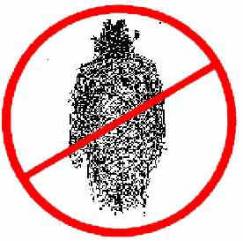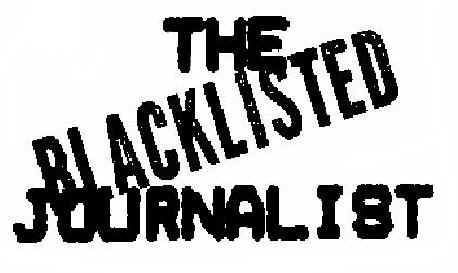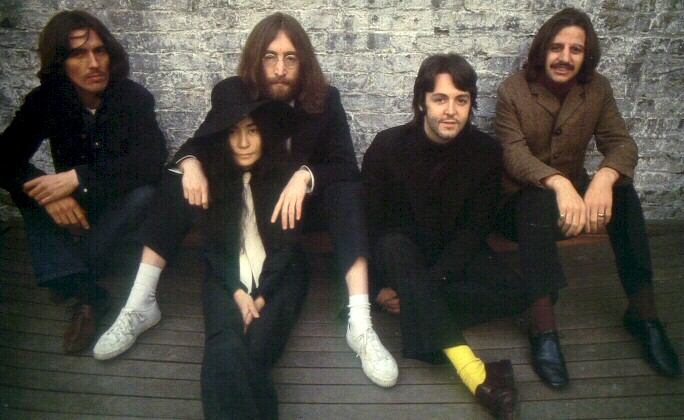
 sm
smCOLUMN SIXTY-NINE, MARCH 1, 2002
(Copyright © 2002 Al Aronowitz)
SECTION TWO

 sm
sm
COLUMN
SIXTY-NINE, MARCH 1, 2002
(Copyright © 2002 Al Aronowitz)
RETROPOP
SCENE:
'LET
IT BE,' THE MOVIE

(Photo by Linda McCartney from her book, "SIXTIES, Portrait of an
Era")
The least that can be said for the movie, Let It
Be, is that it gives you a chance to spend 90 minutes with the Beatles.
If that's not enough, you can stay and see the movie twice.
It's been almost seven years now since John, Paul, George and Ringo
started living their lives In public and they've
learned not only how to function while constantly being watched, but how to
function and still make people want to keep on watching them.
Does it make any difference to a Beatle that there
happens to be a movie camera in the room?
After you get used to one pair of eyes studying how you pick your nose,
the next hundred million pairs of eyes come easy.
Of course it would be simple to criticize the Beatles
for not offering more for the money than just themselves.
Unfettered by any script, uncomplicated by any plot, Let it Be
offers the kind of structure you get when you start to pile one kindergarten
block on top of another. You reach a point where, if you add one more, the whole
construction tumbles.
It was shot In 16 millimeter with little more
premeditation
than anyone would need to take home movies.
Vaguely, the Beatles thought, it might turn into a television film.
Now we see it in first-run movie houses grossing more than a million
dollars in 14 days. The negative only cost $120,000.
Aren't the Beatles entitled to get paid for being
such public figures? In Let It
Be, we see them in a recording studio.
There is nothing more tedious in music than the long hours spent in a
recording studio. Then we see them
in a live performance on the roof of Apple.
A live performance on the roof of Apple?
They blow steam into the chill London winter.
John rubs his hands to warm them for his guitar.
He has to perform in a coat. So
does George. The drum is nailed
down in the wrong place. The police come to serve a noise complaint.
John forgets a lyric and grins into the camera as he sings a dummy line
of gibberish. A mob gathers in the
streets below. Crowds accumulate on
neighboring rooftops. The sound,
only adequately recorded on a Nagra, is distorted in the wind.
And then the movie's over.
If
it sounds like a bomb, it's got an awful long fuse. See it a few times and you'll find it grows rather than wears
on you. The Beatles have more to
sell than their privacy, or haven't you heard?
Let It Be is not just a documentary, it's a spectacular show.
And in addition to being a show, it also becomes a drama.
Who among you will walk in to see it not knowing how it fits into the
saga of the Beatles?
When the picture opens, John has already abdicated
his leadership of the group to pursue his love for Yoko. She sits constantly at
his side in the midst of the four of them.
John kisses her passionately, and then dances with her to I, Me, Mine,
a song that George describes as "a heavy waltz." In the meantime, you
see the tensions unfold on the screen as Paul unsuccessfully tries to assume the
leadership.
He lectures John on why the Beatles should play
audiences. He makes fun of the way
they all behaved in Rishikesh with the Maharishi. He tells them to quit fooling
around or "we'll be here all bloody day." He tries to be a nice guy
about it but, in one of the most revealing moments of the film, he also comes
down hard on George.
There is a musical disagreement between the two of them and you can see the embarrassment as Paul leans forward trying to escape the microphone, almost whispering, "I always feel as though I'm annoying ya ... I'm not trying to get
'I'll,
play whatever
you want me to play
or I won't play at all. . .'
ya, but really I'm trying to say. . ." George
reacts with emotion at so public an attack.
"I'll, play whatever you want me to play or I
won't play at all if you don't want me to play," he answers.
"I'll do anything that will please you." In the theater, the
audience breaks into laughter.
Actually,
George quit after that episode and for the next few days, the cameras focused on
his empty chair. Producer Neil
Aspinall later cut the empty chair from the film to preserve its tightness, but
still the movie remains straightforward and uncompromising in its exposure of
these four musical lives.
Of
course Paul emerges the star of the film, whether hero or anti-hero, disheveled
and bearded with a bruise on his, lip from a bike accident, playing bass, piano,
acoustical guitar, conducting, directing and singing most of the songs. Nothing
the others do seems to satisfy him. Not
that he doesn't make any sense.
"It's
complicated now," he tells the others at one point.
"If we can get it simpler and then complicate it. . ."
In the theater it's another laugh.
On the screen, the tension builds. When Paul loses interest during a
rehearsal of John singing Dig a Pony, John suddenly stops.
"Has anybody got a fast one?" he says.
As for the songs, there are plenty of them, although
they're all in bits and pieces until the Beatles finally get onto the Apple
rooftop. It's been years since
anyone saw the Beatles perform live and this is the closest you probably will
come to seeing them perform live for years more.
The magic is still there, and you don't have to witness it from the top
tier of some ballpark, even if it is only on film.
They sing Get Back, Don't Let Me Down, Long
and Winding Road, Let It Be, and a good few others, including The Two of
Us, which may as well be the story of John and Paul.
As the song, says, they have memories now longer than the road that stretches out ahead. ##
CLICK HERE TO GET TO INDEX OF COLUMN SIXTY-NINE

CLICK HERE TO GET TO INDEX
OF COLUMNS
The
Blacklisted Journalist can be contacted at P.O.Box 964, Elizabeth, NJ 07208-0964
The Blacklisted Journalist's E-Mail Address:
info@blacklistedjournalist.com
![]()
THE BLACKLISTED JOURNALIST IS A SERVICE MARK OF AL ARONOWITZ